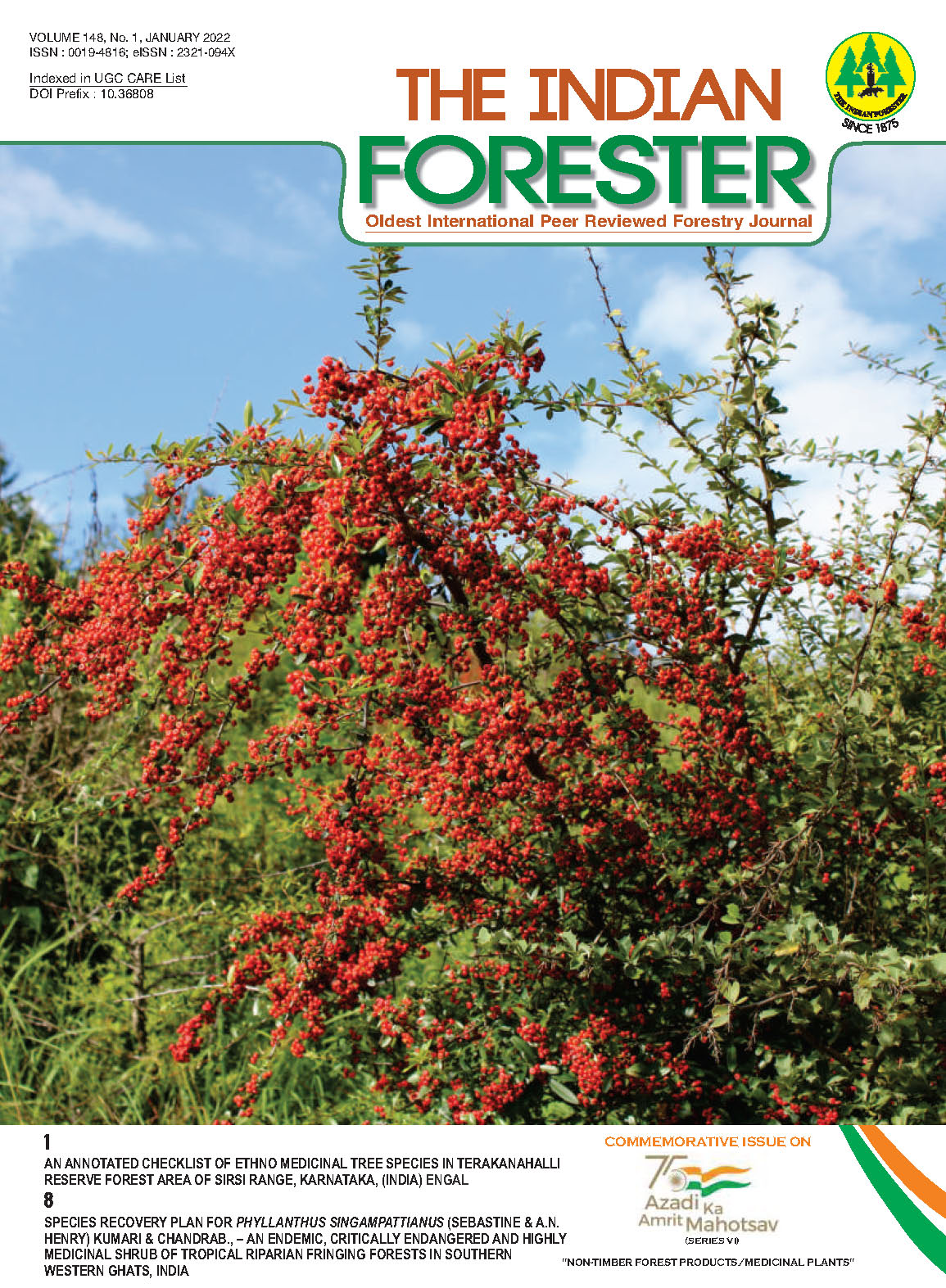Species Recovery Plan for Phyllanthus Singampattianus (Sebastine & A.N. Henry) Kumari & Chandrab., – An Endemic, Critically Endangered and Highly Medicinal Shrub of Tropical Riparian Fringing Forests in Southern Western Ghats, India
DOI:
https://doi.org/10.36808/if/2022/v148i1/165392Keywords:
Species Recovery Plan, Phyllanthus singampattianus, Strict Endemic, Geoinformatics, Artificial Regeneration, In-Situ and Ex-Situ ConservationAbstract
Phyllanthus singampattianus (Sebastine and A.N. Henry) Kumari and Chandrab is one of the strict endemic and critically endangered woody shrub of Euphorbiaceae family with high ethnobotanic properties. It naturally occurs in Tropical riparian fringing forests of Southern Western Ghats, India. The species has a very narrow endemic zone of distribution in Tirunelveli Hills of Tamil Nadu. The habitats of the species in Kalakad Mundanthurai Tiger Reserve (KMTR) were analysed using GPS and stratified random sampling techniques. Satellite remote sensing data with the aid of GIS were used for site-specific mapping of the threatened species and identification of the status of niches with regard to its growth and degradation. Growth habit, botanical description, silvicultural characters, ethno botanic and other utility of the species are provided with photographs. The places of endemism, precise point-location data on the phytogeographic parameters of the area are illustrated with relevant maps. The immediate need to protect and propagate this strict endemic and critically endangered species is emphasized and its methods of artificial regeneration are elaborated. Finally, Threatened Species Recovery Plan (TSRP) has been suggested to protect, promote and conserve the species using in-situ and ex-situ conservation methods.References
Ahmedullah M. and Nayar, M. P. (1986). Endemic plants of the Indian region. Peninsular India. Vol. 1: 1-261.181 Botanical Survey of India, Calcutta.
Champion G.H. and Seth S.K. (1968). Forest Types of Southern India, Government Press, Forest Research Institute, Dehradun, 1968, xiii+402pp.
Gopalan R. and Henry A.N. (2000). Endemic Plants of India, Bishen Singh Mahendra Pal Singh, Dehra Dun, 2000, pp. 327–331.
Government of India - The Wild life (Protection) Act, (1972) and Amendment Act, 2002 Ministry of Environment and Forest, New Delhi.
Government of India, Ministry of environment and Forests, Press Information Bureau on July 14, 2010. Phyllanthus singampattianus (Sebastine and A.N. Henry) Kumari and Chandrab. Enlisted as critically endangered plants of family Euphorbiaceae.
Government of Tamil Nadu, Department of environment, Panagal Buildings, No. 1, Jeenis Road, Saidapet, Chennai– 600 015. Tamil Nadu, India
Management Strategies for Endemic and Threatened Medicinal Plants in India, - A Geoinformatic Approach (2012). Authored by Manoj Kumar Sarkar, Number text pages : 1-596.
Government of India, National Biodiversity Authority, 5th Floor, TICEL BIO Park, Taramani, Chennai - 600 013. http://www.nbaindia.in Year of publication: October 2012,"Biodiversity Governance for Managing Endemic and Threatened Medicinal Plants in India - A Geoinformatic Approach"(2012) Authored by Manoj Kumar Sarkar, Number text pages : 1-202.
Henry A.N., Vivekananthan K. and Nair N.C. (1978). Rare and Threatened flowering plants of South India, Journal of Bombay Natural Hist. Soc., 75(3): 694, 1978.
IUCN (International Union for Conservation of Nature and natural Products), IUCN Red List Categories, version 3.1, prepared by the IUCN Species Survival Commission. Gland, Swizterland. 2001.
Kumari and Chandrab (1987). Phyllanthus singampattianus (Sebastine and Henry) in Henry, Kumari and Chithra, Fl. Tamil Nadu, 2: 238. 1987.
Nayar M.P., Hotspots of Endemic Plants of India, Nepal and Bhutan. The Director. TBGRI. Trivandrum, 1996, p. 252.
Nayar M.P. and Sastry A.R.K. (Eds.) (1987, 1988, 1990). Red Data Books of Indian Plants. Vol. 1.II,III Botanical Survey of India, Calcutta.
Parthasarathy N. and Mahadevan A. (1987). Short communications. Reidia (sic) singampattiana Sebastine et Henry (Euphorbiaceae): a rare and little-known taxon from Western Ghats. Bull. Bot. Surv. India, 27. (1-4): 259 (1985 publ. 1987).
Sarcar, Manoj Kumar (2005). A Framework for Strategic Management of Medicinal Plants Indian Institute of Management, Bangalore; Management Review, Vol. 17, No.4, December 2005, 29,133.
Sarcar, Manoj Kumar., Sarcar Aruna Basu and Chelladurai, V. Rehabilitation approach for Eugenia singampattiana Beddome – an endemic and critically endangered tree species of southern tropical evergreen forests in India, Current Science, Vol. 91, No. 4, 25 August 2006,472-481.
Sarcar, Manoj Kumar (2009). Phyto-Chemical Analysis and Activity of Components identified in Janakia arayalpatra [Tuber Dust] 123; Phyllanthus singampattianus [Leaf Dust] 124; and [Stem Dust] 125; Syzygium nessianum [Fruit Dust] 126 by Gas chromatograph -Mass detector (GC-MS) Method: at Indian Institute of Crop Processing Technology, Thanjavur, Tamil Nadu.
Sarcar, Manoj Kumar. “Conservation and management strategies for endemic and threatened medicinal plants in Kalakad Mundanthurai Tiger Reserve (KMTR), Southern Western Ghats of Tamil Nadu, India - A Geoinformatic Approach; Ph.D Thesis. St.Joseph's College, Bharathidasan University, Tiruchirapalli, Tamil Nadu, INDIA, 2010, 182-187, ix+240pp.
Sebastine K.M. and A.N. Henry Reidia singampattiana in Bull. Bot. Surv. India, 2: 43. 1960, 1978, 1987.
Surveyor General of India, Survey of India Maps No 58 H/1, 58 H/2 , 58 H/5, 58 H/6, 58 H/7, 58 H/10 and 58 H/11; Kerala, Tamil Nadu First (1:50,000) 1978, 1969.
Trewartha G.T., An Introduction to climate McGraw- Hill Book Company, Inc. 1954, 381, pp 395.
Viswanathan M.B., Prem Kumar E.H. and Ramesh N. (2006). Ethnobotany of the Kanis (Kalakkad Mundanthurai Tiger Reserve in Tirunelveli District, Tamil Nadu, India). Pp. 1-177. Bishen Singh Mahendra Pal Singh, Dehradun.
Walter Kerry S. and Gillett Harriet J (ed): (1997). IUCN Red List of Threatened Plants, IUCN – The World conservation Union, 1998. Appn.lii 862.
WCMC, INDIA (1996) – all Nationally Threatened Taxa listed at WCMC, Conservation status listing of plants. 1996, pp.1-172. Cambridge. (Johanna Sidey in litt., 5 June,1996).
WCMC (World Conservation Monitoring Centre), Global Biodiversity, Chapman Hall. London, 1992.
Downloads
Downloads
Published
How to Cite
Issue
Section
License
Unless otherwise stated, copyright or similar rights in all materials presented on the site, including graphical images, are owned by Indian Forester.





